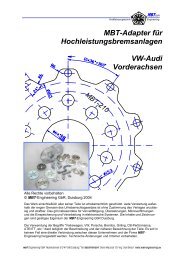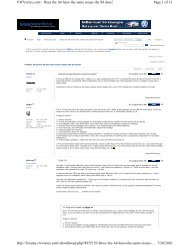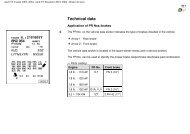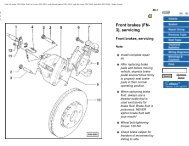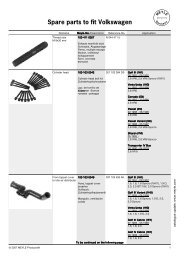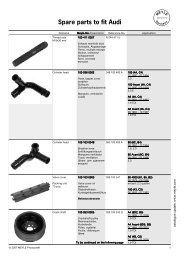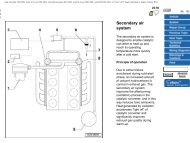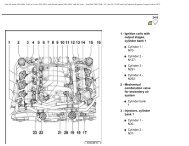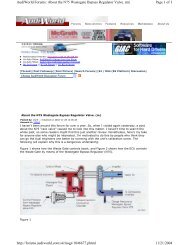VW MKII A2 MK2 Golf Jetta Fox Service Manual - VAGLinks.com
VW MKII A2 MK2 Golf Jetta Fox Service Manual - VAGLinks.com
VW MKII A2 MK2 Golf Jetta Fox Service Manual - VAGLinks.com
You also want an ePaper? Increase the reach of your titles
YUMPU automatically turns print PDFs into web optimized ePapers that Google loves.
4B•4 Fuel and exhaust systems - K-Jetronic fuel injection - 8 valve engines<br />
f) DO NOT use fuel or engine oil additives<br />
as these may contain substances harmful<br />
to the catalytic converter.<br />
g) DO NOT continue to use the vehicle if the<br />
engine burns oil to the extent of leaving a<br />
visible trail of blue smoke. The unburned<br />
carbon deposits will clog the converter<br />
passages and reduce its efficiency. In<br />
severe cases, the element will overheat.<br />
h) Remember that the catalytic converter<br />
operates at very high temperatures, hence<br />
the heat shields on the vehicle’s<br />
underbody. The casing will be<strong>com</strong>e hot<br />
enough to ignite <strong>com</strong>bustible materials<br />
which brush against it. DO NOT, therefore,<br />
park the vehicle in dry undergrowth, over<br />
long grass or piles of dead leaves.<br />
I) Remember that the catalytic converter is<br />
FRAGILE. Do not strike it with tools during<br />
servicing work, take great care when<br />
working on the exhaust system, ensure<br />
that the converter is well clear of any jacks<br />
or other lifting gear used to raise the<br />
vehicle and do not drive the vehicle over<br />
rough ground, road humps etc. in such a<br />
way as to `ground’ the exhaust system.<br />
j) In some cases, particularly when the<br />
vehicle is new and/or is used for<br />
stop/start driving, a sulphurous smell (like<br />
that of rotten eggs) may be noticed from<br />
the exhaust. This is <strong>com</strong>mon to many<br />
catalytic converter-equipped vehicles and<br />
seems to be due to the small amount of<br />
sulphur found in some petrols reacting<br />
with hydrogen in the exhaust to produce<br />
hydrogen sulphide (H2S) gas. While this<br />
gas is toxic, it is not produced in sufficient<br />
amounts to be a problem. Once the<br />
vehicle has covered a few thousand miles<br />
the problem should disappear. In the<br />
meantime, a change of driving style or<br />
brand of petrol used may effect a<br />
solution.<br />
k) The catalytic converter used on a wellmaintained<br />
and well-driven vehicle,<br />
should last for between 50 000 and<br />
100 000 miles. From this point on, careful<br />
checks should be made at all specified<br />
service intervals of the CO level to ensure<br />
that the converter is still operating<br />
efficiently. If the converter is no longer<br />
effective, it must be renewed.<br />
3 Air cleaner element - renewal<br />
Refer to Chapter 1, Section 32<br />
4 Idle speed - adjustment<br />
1<br />
4<br />
1 Run the engine until the oil temperature is<br />
at least 80°C. Do not let the engine coolant<br />
temperature rise above normal as the electric<br />
4.6 Idle speed adjustment screw location<br />
in throttle valve housing (arrowed)<br />
radiator fan will run and this should not be<br />
operating when checking or adjusting idle<br />
speed.<br />
2 Check the ignition timing and adjust if<br />
necessary.<br />
3 Except on air conditioned models, the main<br />
headlights should be turned on. Disconnect<br />
and plug the crankcase breather hose from<br />
the valve cover.<br />
4 Where air conditioning is fitted, the system<br />
must be switched off during checking and<br />
adjustment.<br />
5 If the injector pipes have been reconnected<br />
just prior to checking the idle speed, run the<br />
engine up to 3000 rpm a few times and then<br />
let it idle for a minimum period of two minutes<br />
before checking the idle speed.<br />
6 If adjustment to the idle speed is necessary,<br />
remove the locking cap from the adjustment<br />
screw on the throttle assembly and turn the<br />
screw to achieve the specified idle speed (see<br />
illustration). Adjustment should be made only<br />
when the radiator fan is stationary.<br />
7 If an exhaust gas analyser is available,<br />
check the CO reading and <strong>com</strong>pare it with the<br />
specified figure. If necessary adjust the idle<br />
mixture.<br />
8 Air conditioned models will also be fitted<br />
with an increased idle speed valve and, in<br />
some instances, a second idle speed boost<br />
valve. To check these, refer to Sections 5 or 6,<br />
as applicable.<br />
5 Increased idling speed valve<br />
(air conditioned models) -<br />
testing<br />
2<br />
1 Start and run the engine at its normal idle<br />
speed.<br />
2 With the air conditioner switched off, pinch<br />
the hose at the increased idle speed valve<br />
(see illustration). The engine speed should<br />
not change.<br />
3 Switch the air conditioning system on and<br />
then repeat the test. This time the engine<br />
speed should drop. If these tests prove the<br />
valve to be faulty then it must be renewed.<br />
4 Disconnect the hose, unclip and detach the<br />
wiring connector then unbolt and remove the<br />
valve from its support bracket.<br />
5 Refit in the reverse order of removal.<br />
1081 <strong>VW</strong> <strong>Golf</strong> & <strong>Jetta</strong><br />
5.2 Increased idling speed valve (air<br />
conditioned models)<br />
6 Idle speed boost (air<br />
conditioned models) - testing<br />
and idle speed adjustment<br />
2<br />
General<br />
1 The function of this device is to stabilise the<br />
engine speed when it drops below 700 rpm<br />
under certain operating conditions. This is<br />
achieved by increasing the air supply to the<br />
engine, which raises the idling speed to<br />
approximately 1050 rpm. At this point, the air<br />
supply valve is cut off and the idle speed then<br />
returns to normal. The two valves which<br />
control this system are attached to the<br />
right-hand front suspension mounting in the<br />
engine <strong>com</strong>partment (see illustration).<br />
2 Valve No. 1 (inboard side) increases the<br />
engine speed when it drops below 700 rpm,<br />
whilst valve No. 2 (outboard side) increases<br />
the idle speed when the air conditioner is<br />
switched on.<br />
Valve 1 - testing and idle speed<br />
adjustment<br />
3 Run the engine up to its normal operating<br />
temperature, switch off the air conditioner and<br />
allow the engine to idle. With the exception of<br />
the air conditioner, switch on all electrical<br />
consumers (lights, etc.), then adjust the idle<br />
speed to 700 rpm. When reaching idle speed,<br />
the valve should open and the idle speed<br />
increase. Using a pair of pliers, pinch the air<br />
hose from the valve then check that the speed<br />
drops.<br />
6.1 Idle speed boost valve check<br />
1 Valve No 1 2 Valve No 2 3 Hose



